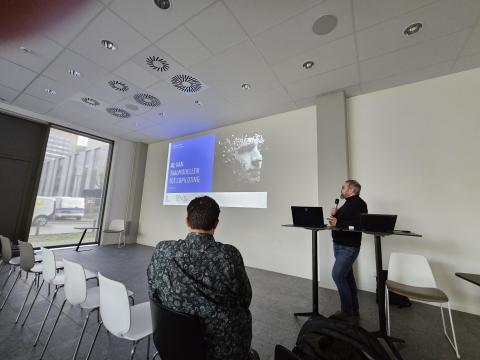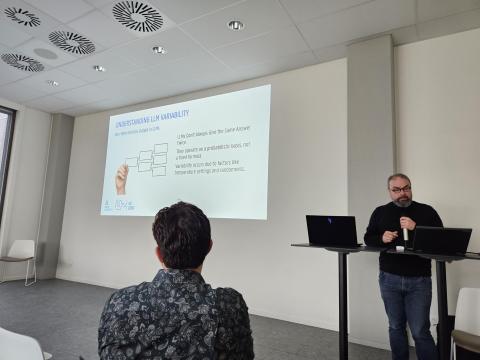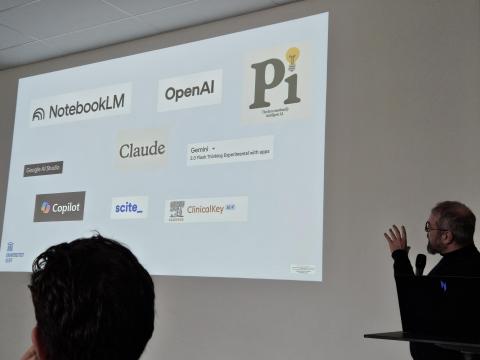On February 27th, 2025, healthcare professionals gathered for the first Pulse Session of HINT.GENT, an event that promised to revolutionize the way we approach healthcare administration and clinical workflows. Led by Dr. François Remy from Biomedical AI and Prof. Dr. Steven Callens from Ghent University Hospital, the session focused on the transformative potential of Large Language Models (LLMs) in healthcare. The enthusiasm and insights shared during this session highlighted how LLMs can help healthcare professionals use their time more efficiently, ultimately enhancing patient care.
Setting the Stage
Dr. François Remy kicked off the session with an in-depth introduction to language models, explaining their fundamental principles and applications in healthcare. His presentation covered several key points:
- Understanding Language Models: dr. François Remy explained that language models are simplifications of real-world phenomena, designed to estimate the likelihood of word sequences in given contexts. These models can predict responses in conversations, making them valuable for various applications such as speech recognition, translation, and question answering.
- Applications in Healthcare: Examples of language model applications include:
- Speech Recognition: Combining auditory input with contextual language models to improve accuracy.
- Text Translation: Utilizing models like DeepL and Google Translate for multilingual communication.
- Question Answering: Leveraging models like ChatGPT and Microsoft Copilot to provide accurate and contextually relevant responses.
- Challenges and Considerations: The presentation also addressed the limitations of language models, such as the need for deep thinking and a critical mindset to ensure accurate and reliable outputs.

AI in Action
Following Dr. Remy's insightful presentation, Prof. Dr. Steven Callens took the stage to showcase practical applications of AI, particularly LLMs, in healthcare settings. He highlighted the principles and methods that underpin effective AI usage. One key takeaway was the importance of grasping principles over methods, quoting Ralph Waldo Emerson: "The man who grasps principles can successfully select his own methods."
Key Takeaways
- Strategic Implementation: Before integrating LLMs into clinical workflows, it is crucial to evaluate the existing processes. Automation applied to efficient operations magnifies efficiency, while automation applied to inefficient operations magnifies inefficiency, as noted by Bill Gates.
- Learning as a Primary Goal: Mastering the capabilities of LLMs is essential. Healthcare professionals should focus on understanding how these models work and how they can be leveraged to enhance clinical practice. One of the important skills is effectively learning how to create prompts. You will often need to instruct the LLM multiple times to refine the output to achieve the desired result. A suggestion shared for generating a desired output is to ask the LLM what prompt is needed to achieve this result directly. You can save this prompt and use it again later.
- Patient-Centric Innovation: Thoughtful use of LLMs can significantly enhance patient care. By automating administrative tasks, healthcare professionals can devote more time to direct patient interactions and complex clinical decision-making.




Transforming Administrative Work
One of the most compelling aspects of the session was the discussion on how LLMs can make administrative work easier for healthcare professionals. Prof. dr. Steven Callens illustrated this with several examples:
- Data Analysis and Preprocessing: LLMs can handle large datasets, preprocess information, and perform statistical analyses, freeing up valuable time for healthcare professionals.
- Manuscript Drafting: From implementing the IMRAD structure to generating figures and tables, LLMs can assist in drafting scientific manuscripts, ensuring compliance with journal requirements and responding to reviewers.
- Publication Finalization: LLMs can refine language, adapt formats, verify citations, and generate impact statements, streamlining the publication process.
Conclusion
The first pulse session of HINT.GENT provided invaluable insights into the potential of Large Language Models in healthcare. By strategically implementing these models, mastering their capabilities, and focusing on patient-centric innovation, healthcare professionals can transform their administrative workflows and enhance clinical practice. How to get started? Apply LLM’s to your work tasks one step at a time or as prof. Dr. Steven Callens would recommend starting with ‘dumb’ AI first, which means replacing simple tasks, such as text writing, with LLMs.
Pro tip: UGent has a license on Microsoft Copilot, go to copilot.microsoft.com and log in with your UGent-account to ensure that all your text and data input is safe and protected under the UGent license 😉